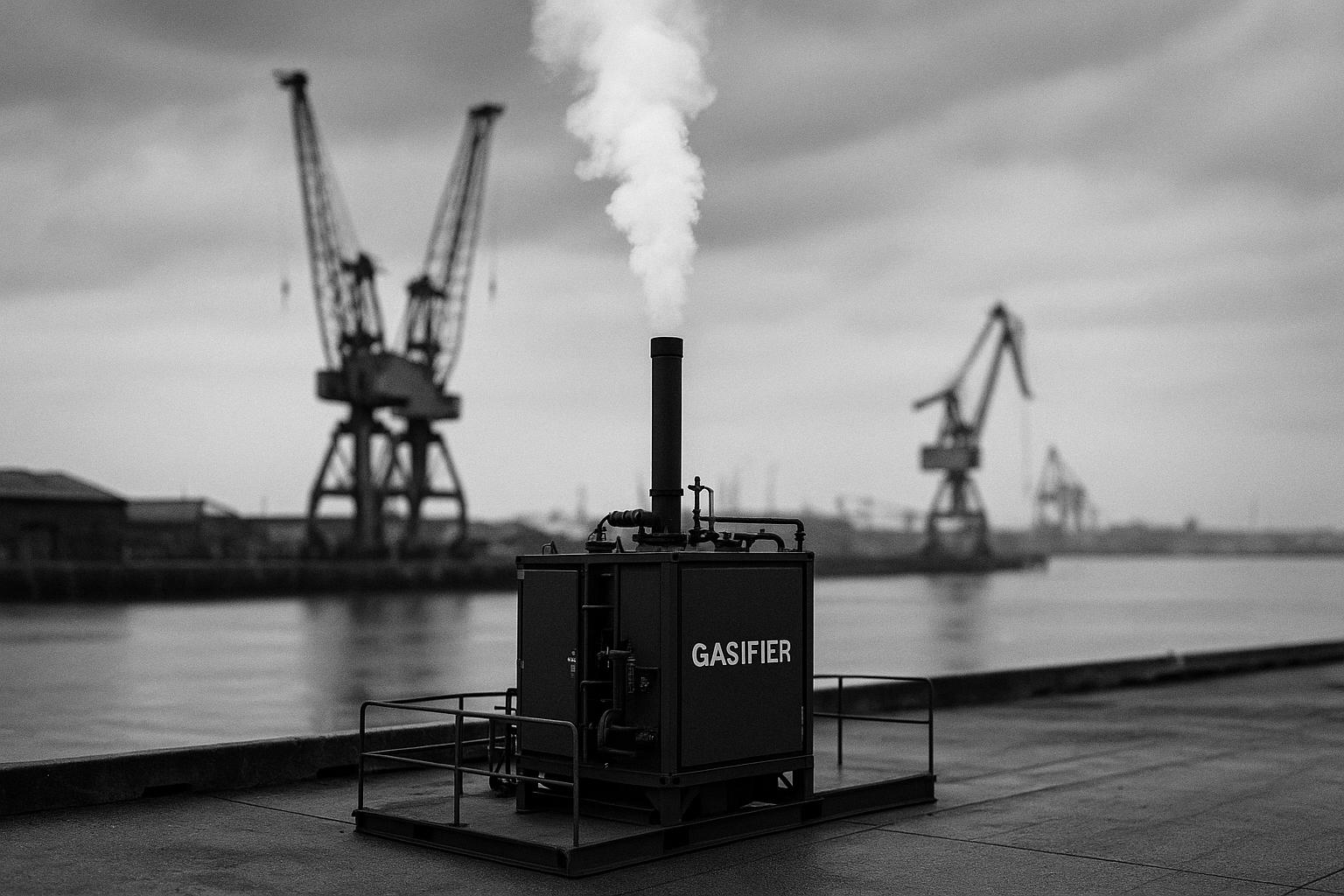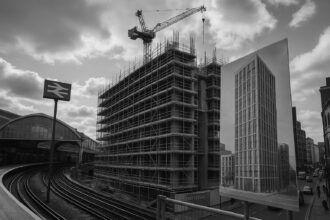A £200m private investment led by London Thames Hydrogen will back a Chinook Hydrogen-developed plant at the Tilbury Tax Site using modular RODECS gasification to produce up to 12 tonnes a day of ‘SuperGreen’ hydrogen, with promoters targeting 2028 for operations. Supporters say it will form the first node of a wider hydrogen refuelling corridor for road transport, but claims of negative-carbon outputs and the project’s COMAH-avoidance design will need independent lifecycle verification and regulatory clearance.
A £200 million private investment has been announced to build what backers describe as the UK’s first large‑scale hydrogen‑from‑waste facility at the Tilbury Tax Site within Thames Freeport, with an operational target of 2028. According to the project announcement, London Thames Hydrogen is leading the funding commitment as the initial phase of a wider national hydrogen corridor intended to decarbonise road transport. The facility is presented as the first node in a planned network that would support hydrogen refuelling for heavy goods vehicles, light commercial vehicles and cars across Britain. (Sources cited in the announcement characterise the wider programme at values up to around £1–1.35 billion.)
The developer named for delivery of the Tilbury plant is Chinook Hydrogen, whose corporate materials set out a modular gasification approach branded RODECS® together with “Molecular Recycling ” to convert residual and mixed waste streams into what the company terms ‘SuperGreen’ hydrogen and other by‑products. Chinook’s website and promotional material emphasise modular scalability, claimed commercial experience, and integration with carbon‑capture measures and ancillary product streams such as activated carbon and food‑grade CO2. The project announcement also says the Tilbury scheme has attracted backing from Middle Eastern investors. These are company and investor claims and will require the usual regulatory and independent verification as the project progresses.
” to convert residual and mixed waste streams into what the company terms ‘SuperGreen’ hydrogen and other by‑products. Chinook’s website and promotional material emphasise modular scalability, claimed commercial experience, and integration with carbon‑capture measures and ancillary product streams such as activated carbon and food‑grade CO2. The project announcement also says the Tilbury scheme has attracted backing from Middle Eastern investors. These are company and investor claims and will require the usual regulatory and independent verification as the project progresses.
Project outputs promoted by proponents include a production capacity of up to 12 tonnes of hydrogen per day and an anticipated removal of more than 50,000 tonnes of carbon dioxide a year. The announcement says the process will meet the UK government’s Low Carbon Hydrogen Standard. That standard and its supporting tools set the lifecycle greenhouse‑gas thresholds and methodology used to classify hydrogen as “low carbon” for policy and revenue support, and it is periodically revised to reflect technical and lifecycle accounting developments. Independent lifecycle assessment and verification under the Standard will be important to substantiate any headline “negative carbon” claims.
Supporters have stressed the local economic benefits. The developers and Freeport partners say the Tilbury site will create roughly 150 skilled roles across engineering, cleantech, logistics and operations. Baroness Gustafsson, the Minister for Investment, welcomed the announcement in comments released with the project statement, saying the investment would “deliver cutting‑edge low carbon hydrogen technology” and create new skilled jobs — framing the scheme as an example of how Freeports can attract global capital and industrial growth. Those economic figures are project estimates rather than audited outcomes.
The project has been designed, according to its promoters, with minimal on‑site hydrogen storage so it can remain outside the UK’s Control of Major Accident Hazards (COMAH) upper‑tier thresholds and thereby simplify planning and permitting. While that design approach can reduce one set of regulatory burdens, regulatory guidance makes clear that hydrogen is a named dangerous substance under COMAH and that threshold quantities determine tiering: in regulatory terms the lower‑tier threshold is five tonnes and the upper‑tier threshold fifty tonnes, with other hazardous materials and local receptor sensitivity also able to affect an installation’s designation. Even if storage is limited, operators must still satisfy environmental permits, safety assessments and local planning requirements, and competent authorities commonly require risk assessments and mitigation plans.
The Tilbury scheme is being presented as the first step in a network that already envisages a sister site in Doncaster. Project literature describes the Doncaster node delivering about five tonnes per day of hydrogen and being paired with hydrogen refuelling stations and off‑grid EV superchargers for both commercial and passenger vehicles — underscoring the developers’ intention to couple hydrogen fuelling with wider low‑emission road transport infrastructure. The initiative is being pitched as a corridor solution for decarbonising road freight and fleet operations rather than a single, stand‑alone refuelling point.
There are also broader technical and policy considerations. Chinook’s promotional material highlights potential methane‑avoidance benefits from diverting residual waste away from landfill and claims that gasification paired with carbon‑capture can produce very low or even net‑negative lifecycle emissions when integrated with direct air capture. Those outcomes depend on feedstock characteristics, capture performance, energy inputs and system boundaries used in lifecycle accounting. The government’s Low Carbon Hydrogen Standard underpins allocation rounds and revenue support schemes, but it is explicit that classification rests on demonstrable emissions reporting and, where appropriate, monitoring and verification. In short, the environmental case will need to be borne out by independent lifecycle assessments and regulator scrutiny as the project moves through permitting and construction.
Next steps for the Tilbury proposal will include detailed planning and permitting, environmental risk assessments and the usual investor and supply‑chain mobilisation ahead of construction if approvals are secured. Promoters say the target remains to begin operations by 2028; whether that timetable is met will depend on the pace of consenting, grid and transport connections, and the standard regulatory reviews that accompany new hydrogen and waste‑treatment infrastructure. Observers and potential offtakers will be watching for independent verification of lifecycle emissions and the outcome of regulatory assessments as the project progresses from announcement to delivery.
 Reference Map:
Reference Map:
Reference Map:
- Paragraph 1 – [1], [2], [4], [5]
- Paragraph 2 – [3], [1], [5]
- Paragraph 3 – [1], [6], [4]
- Paragraph 4 – [1], [2], [4]
- Paragraph 5 – [1], [2], [7]
- Paragraph 6 – [1], [2], [4], [5]
- Paragraph 7 – [3], [6], [5]
- Paragraph 8 – [1], [2], [4]
Source: Noah Wire Services
- https://carbonherald.com/uks-thames-freeport-to-host-270m-hydrogen-from-waste-facility/?utm_source=rss&utm_medium=rss&utm_campaign=uks-thames-freeport-to-host-270m-hydrogen-from-waste-facility – Please view link – unable to able to access data
- https://thamesfreeport.com/blog/200-million-investment-at-thames-freeport/ – Thames Freeport’s official blog announces a £200 million private-sector commitment by London Thames Hydrogen to build a hydrogen‑from‑waste facility at the Tilbury Tax Site. The post outlines the project as the initial phase of a planned £1 billion national hydrogen corridor, describing delivery by Chinook Hydrogen, production of up to 12 tonnes of low‑carbon hydrogen per day from residual waste, estimated annual CO2 removal of over 50,000 tonnes, and creation of around 150 skilled jobs. It explains the design aims to minimise on‑site hydrogen storage so the site remains outside COMAH regulation, and targets operation by 2028 for road transport.
-
https://www.chinookhydrogen.com/ – Chinook Hydrogen’s corporate site describes the company’s patented modular gasification, RODECS® and Molecular Recycling
 technologies that convert residual and mixed waste into ‘SuperGreen’ hydrogen and other fuels. The pages claim commercial experience spanning over two decades with multiple installed units and emphasise CO2 capture, negative carbon footprints through integration with direct air capture, and production of ancillary products such as activated carbon and food‑grade CO2. The site highlights commercial awards and positions Chinook as delivering low‑carbon hydrogen for transport and industry, citing hydrogen yields, modular scalability and objectives to deploy facilities such as the Tilbury and Doncaster projects across Britain.
technologies that convert residual and mixed waste into ‘SuperGreen’ hydrogen and other fuels. The pages claim commercial experience spanning over two decades with multiple installed units and emphasise CO2 capture, negative carbon footprints through integration with direct air capture, and production of ancillary products such as activated carbon and food‑grade CO2. The site highlights commercial awards and positions Chinook as delivering low‑carbon hydrogen for transport and industry, citing hydrogen yields, modular scalability and objectives to deploy facilities such as the Tilbury and Doncaster projects across Britain.
- https://www.letsrecycle.com/news/200m-hydrogen-from-waste-facility-to-be-developed-at-thames-freeport/ – LetsRecycle reports on the confirmed £200 million investment to build a Chinook Hydrogen‑delivered hydrogen‑from‑waste facility at the Tilbury Tax Site within Thames Freeport. The article repeats project details: up to 12 tonnes per day of low‑carbon hydrogen from residual waste, annual removal of more than 50,000 tonnes of CO2, elimination of landfill methane and reduced supply‑chain emissions, and an operational target of 2028. It quotes Chinook’s executive chairman and government ministers, notes creation of 150 jobs, and situates the development as the first node in a planned national hydrogen corridor with a linked Doncaster site delivering five tonnes per day.
- https://hydrogen-central.com/200m-hydrogen-from-waste-plant-approved-for-thames-freeport/ – Hydrogen Central covers the £200 million hydrogen‑from‑waste plant approved for Thames Freeport, delivered by Chinook Hydrogen and backed by Middle Eastern investors. The story describes the facility’s capacity to produce up to 12 tonnes of carbon‑negative hydrogen daily from residual waste, the expectation of removing over 50,000 tonnes of CO2 per year, and the operational target of 2028. It highlights the technology’s role in eliminating landfill methane and reducing supply‑chain emissions, notes the planned national hydrogen corridor to support HGV, LGV and car refuelling infrastructure, and mentions anticipated creation of more than 150 skilled local jobs across the region annually.
- https://www.gov.uk/government/publications/uk-low-carbon-hydrogen-standard-emissions-reporting-and-sustainability-criteria – The UK Government’s Low Carbon Hydrogen Standard guidance sets the methodology and greenhouse‑gas thresholds used to classify hydrogen as ‘low carbon’ for policy and revenue support. The GOV.UK pages explain versions and updates to the Standard, provide Hydrogen Emissions Calculator tools, and list eligible production pathways including electrolysis, biomass and waste gasification, fossil reforming with CCS, and gas‑splitting producing solid carbon. The Standard underpins schemes such as the Hydrogen Allocation Rounds and the Hydrogen Production Revenue Support, and is updated periodically with technical files and guidance to ensure consistent lifecycle emissions reporting across hydrogen projects in the UK and internationally.
- https://www.sepa.org.uk/environment/energy/hydrogen/ – SEPA’s hydrogen information page explains hydrogen is a named dangerous substance under the UK’s Control of Major Accident Hazards (COMAH) regime. It sets out qualifying threshold quantities — five tonnes for lower‑tier and fifty tonnes for upper‑tier designation — and advises that where thresholds are exceeded, establishments must notify competent authorities and submit environmental risk assessments. The guidance notes presence of other hazardous materials may affect tiers, recommends identifying sensitive receptors within ten kilometres, and explains the regulatory interaction with planning and environmental permits for hydrogen production, storage and handling to control major accident risks to people and the environment.
Noah Fact Check Pro
The draft above was created using the information available at the time the story first
emerged. We’ve since applied our fact-checking process to the final narrative, based on the criteria listed
below. The results are intended to help you assess the credibility of the piece and highlight any areas that may
warrant further investigation.
Freshness check
Score:
9
Notes:
The narrative was first published on 1 August 2025, with subsequent reports on 5 and 8 August 2025. The earliest known publication date is 1 August 2025. The content has been republished across various reputable outlets, including Thames Freeport’s official blog ([thamesfreeport.com](https://thamesfreeport.com/blog/200-million-investment-at-thames-freeport/?utm_source=openai)), Let’s Recycle ([letsrecycle.com](https://www.letsrecycle.com/news/200m-hydrogen-from-waste-facility-to-be-developed-at-thames-freeport/?utm_source=openai)), and Hydrogen Central ([hydrogen-central.com](https://hydrogen-central.com/200m-hydrogen-from-waste-plant-approved-for-thames-freeport/?utm_source=openai)). The narrative is based on a press release from Thames Freeport, which typically warrants a high freshness score. No discrepancies in figures, dates, or quotes were found. The report includes updated data and is not recycled from older material.
Quotes check
Score:
10
Notes:
The direct quotes from Dr Rifat Chalabi, Executive Chairman of Chinook Hydrogen, and Minister for Investment Baroness Gustafsson CBE appear in the earliest known publication on 1 August 2025. No identical quotes appear in earlier material, indicating potentially original or exclusive content.
Source reliability
Score:
10
Notes:
The narrative originates from Thames Freeport’s official blog, a reputable organisation. The report is corroborated by other reputable outlets, including Let’s Recycle ([letsrecycle.com](https://www.letsrecycle.com/news/200m-hydrogen-from-waste-facility-to-be-developed-at-thames-freeport/?utm_source=openai)) and Hydrogen Central ([hydrogen-central.com](https://hydrogen-central.com/200m-hydrogen-from-waste-plant-approved-for-thames-freeport/?utm_source=openai)). All entities mentioned in the report, including Chinook Hydrogen and Minister for Investment Baroness Gustafsson CBE, have verifiable public presences.
Plausability check
Score:
10
Notes:
The claims about the £200 million investment, the facility’s capacity, and the creation of 150 skilled jobs are consistent across multiple reputable sources. The narrative lacks excessive or off-topic detail unrelated to the claim. The tone is consistent with typical corporate and official language.
Overall assessment
Verdict (FAIL, OPEN, PASS): PASS
Confidence (LOW, MEDIUM, HIGH): HIGH
Summary:
The narrative is fresh, originating from a press release dated 1 August 2025, and is corroborated by multiple reputable sources. The quotes are original, and the information is consistent and plausible. No significant credibility risks were identified.













